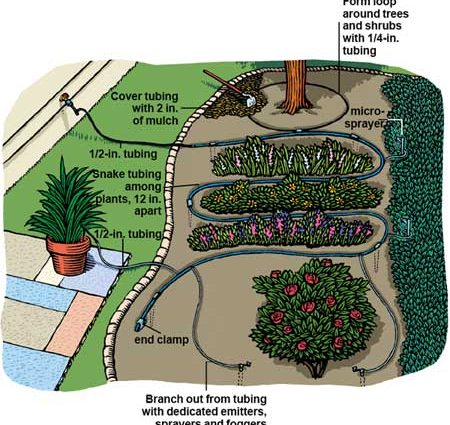Contents
All plants and crops need watering. There are several ways to carry out this process. But you always want the work to be efficient and take a little time, as well as save strength and energy. Drip irrigation of the garden is an excellent solution for the conservation of water resources and their rational use with maximum benefit.
Advantages of drip irrigation
How to make a drip irrigation system and achieve a uniform distribution of moisture over the site, this issue worries many gardeners and gardeners. Indeed, this method of watering has a decent number of advantages in comparison with the others.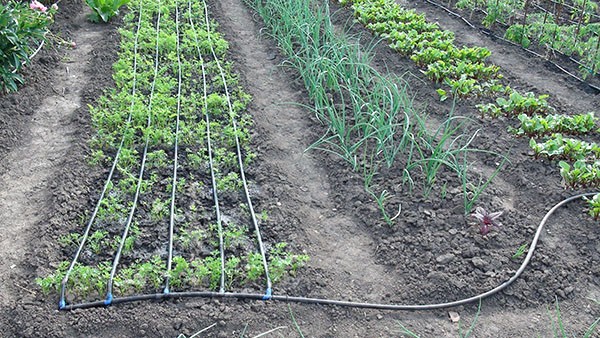
Due to the fact that automatic drip irrigation, like simple local irrigation, is very simple, it is not difficult to make it. It has a tank with water, which is transmitted through pipelines and seeps through the holes under the influence of its own weight. It is important to correctly and accurately place the irrigation system. So that the drops fall under the root system of the plant, and do not spill nearby. So, water is spent very economically and gets to the right place.
Thanks to the drip system, the soil does not become waterlogged, and the root system maintains optimal ventilation throughout the entire growth period. Oxygen exchange does not stop, and the root system develops beautifully. In addition to the fact that plants receive water, they also absorb micronutrients. In dry climatic conditions, this method is very effective and relevant.
In addition, irrigation in this way makes it possible to keep the leaves dry, and they are less susceptible to various diseases.
On difficult plots of land with a slope, this irrigation method also wins against all the others. It prevents soil erosion, and plants receive maximum moisture. In addition, the plants ripen earlier, because the soil temperature is higher than with other irrigation methods.
Undoubtedly, such irrigation systems save a lot of effort and energy. After all, you do not need to drag buckets of water indefinitely or build complex structures.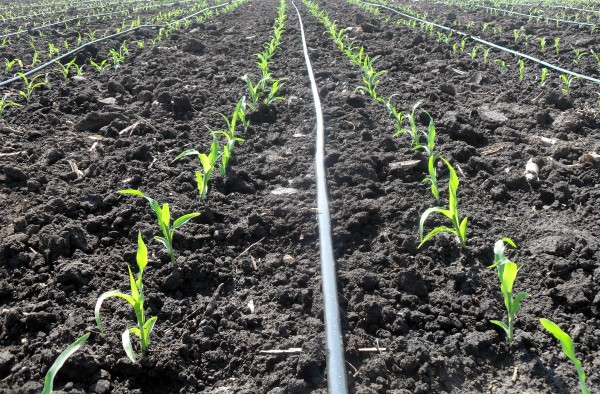
You can harvest at any convenient time, the areas between the beds are not moistened, and the irrigation period does not interfere with the collection. The drip irrigation system makes it possible to grow plants in soils with a moderate salt component. After all, for irrigation, you can use slightly salted water.
Video “Installing the system”
From the video you will learn how to install the purchased irrigation system.
Varieties
Depending on where drip irrigation will be used, the following types are distinguished: greenhouse, indoor, for open area systems. The principle of operation is the same for them, but they also have their own characteristics.
For greenhouse
In order to understand how to assemble a system for a greenhouse, it is necessary to decide for which plants it will be used. If these are perennial crops, then the irrigation system becomes stationary. In case of application for temporary plants, the irrigation structure must be mobile.
Before you make drip irrigation, you should draw a sketch of the greenhouse itself. Indicate the dimensions, dimensions of the structure and draw the location of the beds.

After that, the hoses are selected. If this system is mobile, then flexible hoses are used, if stationary, rigid ones. Hoses are different, the main thing is to choose the most convenient and practical option.
It is important to consider the placement of the water tank and its size. The volume of the tank is selected based on the size of the greenhouse itself. The place should be convenient for approach and filling.
It is important to calculate the additional elements and the cost of them.
After such preparations, the process of independent construction begins:
- install a water storage tank;
- it is necessary to mount hoses and pipelines;
- produce wiring and taps;
- droppers are made using: ready-made sleeves (purchased in a store), making holes (using a heated nail), taps are made – “antennae”.
At the end of all work, the parts are connected into a single whole and the drip irrigation system is launched.
For open area
You should know how to make such a system for an open area. There are a number of features, namely:
- due to the fact that the open summer cottage has a large area, the volume of the vessel with water increases;
- consider the option with the selection of water from an external source;
- hoses made of a material that is resistant to sunlight should be used.
It is necessary to take into account weather conditions, namely frosts and the case when the water in the hose can freeze.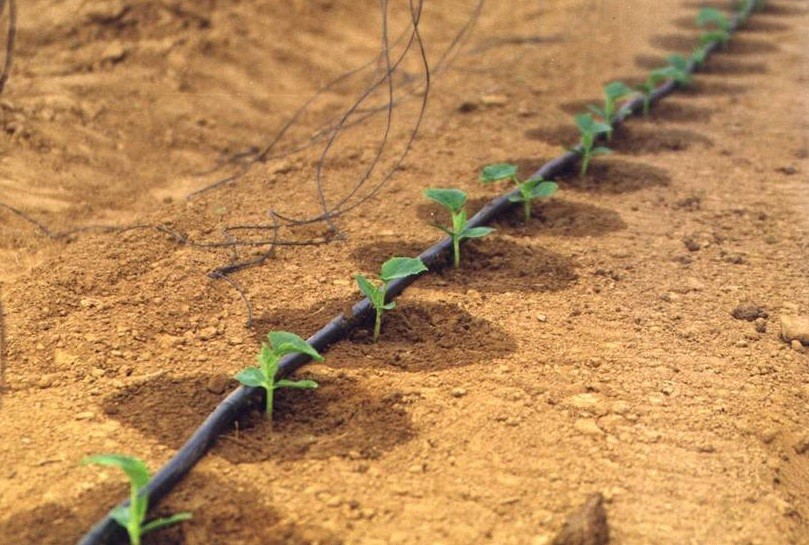

If there are long distances, then a pump with a hydraulic accumulator is connected. In this case, the irrigation process will not be difficult and without interruption.
For indoor flowers
Such an irrigation system is always useful at home. Especially in cases of long absence of owners. Drip irrigation allows you to take care of several plants at once, such a system is able to exist independently and be used repeatedly.
First you need to choose a container for water, based on the number of plants. It can be a bucket or plastic bottles. Then drip systems are installed, it is optimal to use medical ones. They are inexpensive, sold in every pharmacy and serve for years.
You can install the system in the following ways:
- simply insert the hoses into the container. In this case, you will have to suck out the water with your mouth to start its flow, in addition, the hoses may fall out of the tank;
- make holes at the bottom of the container and insert the hoses into them. Pre-heat them to fix them firmly. Additionally, you can use a sealant.

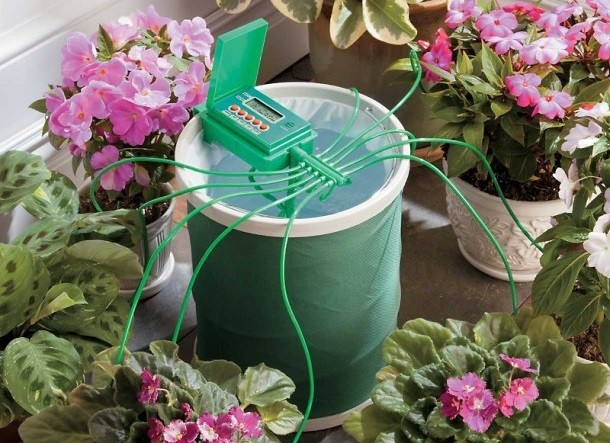
Thus, it is worth noting that not only drip irrigation of the garden is possible, but also indoor flowers and plants.
manufacturing processes
What nuances should be considered when constructing drip irrigation for plants? Here is some of them:
- the most important is the water source. The minimum volume (for street watering) is 200 liters. If you take too small a tank, then it will quickly run out of water, and a large one takes up a lot of space;
- important factors are filters and valves. It will take several taps. One for opening and closing the system, the second in case of draining water from the tank. The filter is needed so that debris, dirt, etc. does not get in;
- pipelines, it is important to choose the right material.
- irrigation drippers themselves (tips or just holes in the hose).
After all the components are assembled, it remains to install a water tank. The top point is selected, you can build a pedestal. The supporting structure is assembled. Faucets are installed and hoses are fixed.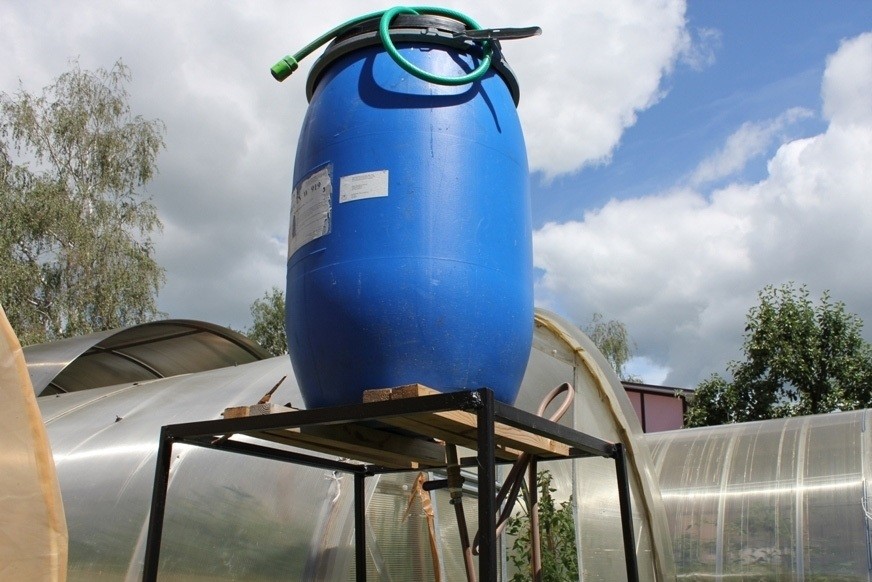

After that, a drip irrigation line is laid. A solid pipe is stretched, then branches are made to each bed and plant. At the end of the straight section, a valve is made, it is screwed with a tap so that it is possible to drain the water if necessary. Then sleeves are attached or holes are made based on where the plant is located.
Drip irrigation systems for summer cottages are efficient, economical in terms of water consumption, human energy and time costs. It is not very difficult to make such a system yourself, the main thing is to take into account some nuances and follow the rules.
Video “How to make an irrigation system”
From the video you will learn how to make your own irrigation system.
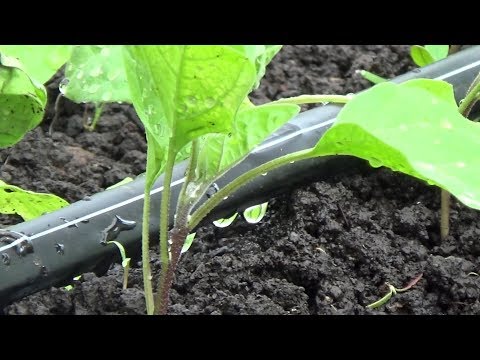

Смотрите это видео на YouTube










